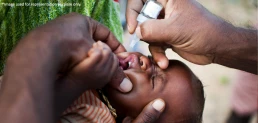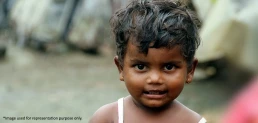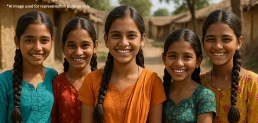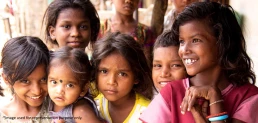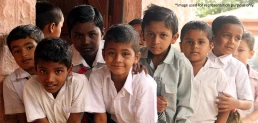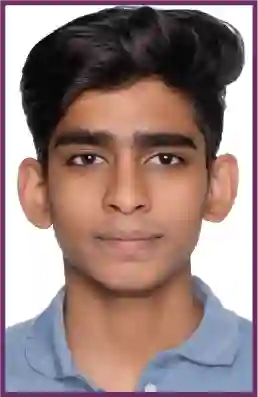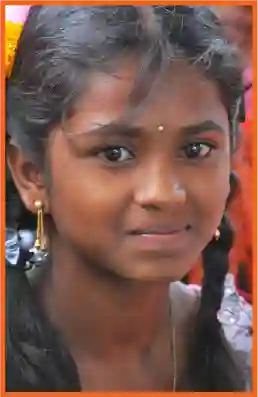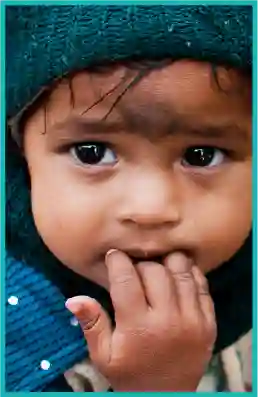Vaccines & newborns: Why immunization is key to infant survival
Every newborn deserves a healthy start to life, and vaccines play a vital role in making that possible. Immunization of infants is the most effective, science-backed way to protect them from life-threatening diseases in their early, most vulnerable months. Yet despite its proven impact, millions of babies still miss out due to inconsistent implementation, limited awareness, and vaccine hesitancy, especially in countries like India.
In this blog, let’s understand how immunization in infants works, why it’s so crucial for their survival, and what it will take to close the awareness gap and build community trust in vaccines.
What is immunization and how does it work?
Infant immunization is the process of giving vaccines to babies to protect them from serious diseases like measles, polio, and tuberculosis. These vaccines help build the baby’s natural defences (immunity) by teaching the body how to fight harmful germs. It keeps babies healthy, prevents illness, and saves lives, especially in their first few years of life.
Importance of vaccination for infant survival
Infants have very limited immunity, which isn’t enough to protect them from the many serious diseases they’re exposed to. Hence, vaccination isn’t just a precaution, but it’s a vital intervention to ensure their healthy living.
- Protection against life threatening diseases
Vaccines protect infants from deadly illnesses such as polio, measles, and tetanus, which can cause severe complications like paralysis or even breathing difficulties in newborns and adults.
- Safeguards vulnerable lives around us
Vaccination not only protects the child receiving it but also helps prevent the spread of disease by shielding those who are too young or medically unable to be immunized.
- Prevents long-term struggles
Skipping vaccination can lead to lifelong health issues and hefty medical bills down the line. On the other hand, timely vaccination is a smart investment of effort where no cost is involved, if one avails them at the government healthcare centers.
- Eliminating diseases for future generations
When a community consistently follows immunization, it can wipe out life-threatening diseases that once posed serious risks. For instance, small pox; it no longer needs a vaccine because it’s been eradicated worldwide.
Key vaccines recommended for infants
Newborns and infants have unique immune responses that differ from adults and animals. Hence, let’s go through their age-specific vaccinations to ensure their well-being.
- Bacillus Calmette-Guerin (BCG)
Given at birth, this single-dose vaccine protects newborns from tuberculosis. - Oral Polio Vaccine (OPV)
OPV is administered at birth, then at 6, 10, and 14 weeks. It protects children under 5 from poliovirus, which can cause paralysis. - Hepatitis B Vaccine
This three-dose vaccine starts within 24 hours of birth, followed by doses between 1–2 months and again at 6–18 months. It protects the liver from hepatitis B virus. - Pentavalent Vaccine
Given at 6, 10, and 14 weeks, it protects against five diseases: diphtheria, pertussis, tetanus, hepatitis B, and Hib. - Rotavirus Vaccine (RVV)
Administered in three doses at 6, 10, and 14 weeks, it guards against rotavirus, this is a major cause of severe diarrhea in infants. - Pneumococcal Conjugate Vaccine (PCV)
PCV is given at 2, 4, and 6 months of age to protect against pneumonia, meningitis, and septicemia.
Also Read: Prioritizing Health and Nutrition for At-Risk Children in India
Addressing vaccine hesitancy among parents
Even in high-income countries like the U.S., 1 in 4 parents choose not to vaccinate their child, according to the U.S. National Library of Medicine. In India, it’s not always about choice, people often hesitate because of low awareness, limited access to healthcare, and the myths that still surround vaccine side effects.
Building trust through healthcare centres
India has a widespread network of Anganwadi Centers (AWCs), Anganwadi Workers (AWWs), and Auxiliary Nurse Midwives (ANMs) to support vaccination efforts. Yet, a significant gap remains in how communities access these services. When frontline workers and doctors engage more closely with people, it helps build trust. By sharing medical information in simple terms and real stories of hope from within the community, often with support from NGOs like CRY America, they make healthcare feel more accessible and relatable.
Capitalizing community stakeholders
Communities don’t easily trust outsiders who enter their space and start pointing out problems. That’s where local leaders like the Sarpanch, religious heads, and Panchayat members play a crucial role. When these leaders are made aware of the importance of vaccination, they become spokespersons and strong advocates for children’s well-being. And because the community trusts them, their message is more likely to be heard and accepted.
Mobilizing complex medical information
People are often more willing to deal with common illnesses than to crack complicated medical jargon. Hence, it’s important to simplify the language used when communicating with underserved communities. When doctors with support from NGOs like CRY America break down complex medical facts into simple, relatable messages; using local languages, illustrations, or culturally familiar analogies, the benefits of vaccination become clearer. And that’s when communities begin to trust the information and take it to heart.
Addressing Societal Fears and Myths
Myths and superstitions often stem from limited awareness passed down through generations. This cycle can only be broken when communities receive information from sources they trust. This credibility is a slow cooked process that ripples when the community stakeholders speak the same language and share consistent messages, whether it’s at the local healthcare center, in a Panchayat Sabha, or through women’s peer groups or mother’s peer groups supported by NGOs like CRY America. As trusted members of the community, these groups advocate for vaccination drives and help dispel myths from within.
Making vaccination accessible
All these efforts can fall short if, despite being informed, people are unable to access vaccines whether due to stockouts at healthcare centers, a shortage of trained nurses, or difficult terrains and long distances that make travel nearly impossible. To tackle these challenges, NGOs like CRY America works closely with local administrations to deploy mobile vaccination units in challenging areas and to support the training of Anganwadi Workers (AWWs) and Auxiliary Nurse Midwives (ANMs).
CRY America’s role in supporting children’s vaccination
Parvatiben, a young mother from an underserved community, almost gave up on immunizing her newborn after he developed swelling following a BCG vaccine, a common and usually mild reaction. Without proper information, such an experience can quickly turn into fear. That’s where CRY America stepped in to bridge the gap between awareness and action through ground-level engagement.
Through CRY’s supported Mother’s Groups, interactive awareness sessions, and one-on-one counseling, the Project GSS team helped her understand the benefits of vaccination and what side effects are normal versus concerning. They accompanied her on visits to the local health clinic and reinforced the importance of completing the immunization schedule for infants, particularly the Pentavalent vaccine, which protects against five life-threatening diseases.
Parvatiben once again found trust in the process, and ensured her child received all three doses on time. Today, she’s not just a mother who made an informed decision, but also a community advocate encouraging other mothers to overcome fears and embrace timely infant immunization.
Conclusion
Vaccination of infants is more than personal protection as it safeguards communities and secures a healthier future for generations. While India’s public health efforts have made considerable progress, the journey is still far from over, and with your continued support can help bridge this gap.
Donate to CRY America and ensure every child receives the protection they deserve because a healthy future begins with timely immunization today.
Anemia in Rural Children: A Health Problem We Can’t Ignore
Anemia in children is a serious health issue that disproportionately affects rural areas in India. It undermines growth, learning, immunity, and long-term development. This guide explores what anemia is, why rural children are at risk, how to identify symptoms, the underlying causes and risk factors of anemia in children, and how CRY America is addressing this issue. It concludes with suggestions for contributing to change.
What is Anemia, and Why is it a Major Concern for Rural Children?
Anemia is defined as a lower-than-normal hemoglobin concentration in blood, reducing oxygen delivery to organs and tissues. Hemoglobin levels drop below 11 g/dL in children aged 6–59 months, according to India’s NFHS-5 data, with a prevalence of 67.1% in this group.
Major concerns:
- Impaired brain development, reduced attention span, and learning difficulties
- Increased susceptibility to infections and fatigue
- Poor school performance and decreased physical capacity
Rural context:
- Restricted access to iron-rich foods and healthcare
- Prevalent anemia becomes intergenerational, affecting community well-being
Also Read: What is malnutrition?
Why Rural Children Are More Vulnerable to Anemia
Rural settings amplify vulnerability due to:
- Lower socioeconomic status and food insecurity
- Poor dietary diversity: dependence on grains over iron-rich foods
- Limited access to health services and routine screening
- Environmental risks: high incidence of parasitic infections (e.g., hookworm, malaria)
- Cultural norms limiting nutrition for girls and young children
Identifying the Signs of Anemia in Children
Early identification is key, as signs of anemia in children may be subtle:
Common Symptoms of Anemia in Children
Bulleted list of symptoms, supported by pediatric sources:
- Pale skin, lips, hands, and under the eyelids
- Irritability and fussiness in toddlers
- Low energy, fatigue, fast heartbeat (tachycardia)
- Sore/swollen tongue, mouth ulcers
- Pica (eating non-food items like dirt or ice)
- Headaches, dizziness, shortness of breath, palpitations
The Consequences of Unrecognized Anemia
- Delayed growth, cognitive, and psychomotor development
- Weakened immunity, increased infection risk
- School absenteeism and long-term performance setbacks
- In severe cases: heart strain, heart failure, and life-threatening complications
| Level of Anemia | Hemoglobin Range | Possible Effects |
| Mild | 10.0-19.0 g/dl | Often asymptomatic, slight cognitive effects |
| Moderate | 7.0-9.9 g/dl | Fatigue, pale appearance, reduced activity |
| Severe | <7.0 g/dl | Paleness, tachycardia, growth delays, cardiac strain |
Also Read: Protect the Health and Nutrition of Marginalized Children in India
Risk Factors Contributing to Anemia in Rural Areas
Limited Access to Nutrition and Healthcare
- Low-income households struggle to afford iron-rich foods
- Skewed diets with rice, millet, and starchy staples
- Lack of fresh fruit/vegetable intake
- Inadequate supplementation and weak screening by ASHA workers
- Insufficient Deworming and Iron Folic Acid programs, despite India’s Anemia Mukt Bharat
Environmental and Cultural Factors Affecting Child Health
- High burdens of parasitic infections and malaria
- Cultural feeding norms prioritizing adults over children
- Gender norms affecting diet for girls and boys alike
- Unsafe water/sanitation leading to repeated infections
Also Read: Prioritizing Health and Nutrition for At-Risk Children in India
What Causes Anemia in Children?
Anemia in children arises due to a mix of nutritional deficiencies and health conditions:
Nutritional Deficiencies: Iron, Folate, and Vitamin B12
- Iron deficiency is the most common cause
- Additional deficiencies: folate, vitamin B12, and vitamin A
- Inadequate dietary intake and poor absorption due to GI issues
Infections and Medical Conditions Leading to Anemia
- Chronic infections: malaria, tuberculosis
- Parasitic infestations: hookworm leading to blood loss
- Hemoglobinopathies (like thalassemia) are genetic contributors
- Chronic diseases, blood loss, and impaired iron metabolism
How CRY America is Fighting Anemia in Rural Children
CRY America supports holistic, evidence-based interventions aligned with Indian government programs to combat anemia:
- Nutrition & Supplementation
- Promotes Iron Folic Acid (IFA) supplementation under Anemia Mukt Bharat
- Encourages dietary diversification: iron-rich meals and vitamin-C intake
- Community Health Screening
- Works with local nonprofits & ASHAs to organize hemoglobin testing camps
- Referrals to primary health centers for treatment and follow-up
- Conducts Community Awareness Programs
- Conducts community hygiene education like WASH programs
- Organizes nutrition Days & educates mothers & community on proper nutrition
- Behavior Change Communication
- Educates caregivers on anemia risks, nutrition, hygiene, and signs of anemia
- Uses audio-visual aids, local advocates, and school-based programs aligned with POSHAN Abhiyaan
- Monitoring & Data
- Champions' use of government digital platforms for anemia tracking
- Partners with schools and health centers to monitor progress
Identifying and Acting: From Signs to Solutions
Signs of Anemia in Children Checklist
- Pale skin, lips, nails, and eyelids
- Persistent tiredness or low activity
- Irritability or emotional change
- Fast heart rate, breathlessness
- Pica behavior
- Recurrent infections or stunted growth
Next Steps if Symptoms Appear
- Hemoglobin test via CBC and ferritin levels
- Nutritional counseling plus supplements (IFA syrup/tablets)
- Deworming and access to hygiene support
- Follow-up monitoring to track recovery
Positive Outcomes: What Restoration Looks Like
Through coordinated action, government programs plus CRY America’s local support, rural children benefit from:
- Improved hemoglobin levels and reduced anemia prevalence
- Better cognitive function and physical energy
- Fewer infections and school absences
- Enhanced community understanding of child nutrition
How to Support the Mission
Positive change, especially for anemia in children, requires community and donor partnership:
- Donate: Funds support nutrition programs & community awareness programs
- Awareness: Share awareness through social platforms and local networks
A donation empowers local teams to reach more children, improving nutrition, health, and future potential.
Final Thoughts
Anemia in rural children is a pressing yet addressable health issue in India. Stronger nutrition, screening, supplementation, hygiene, and behavior change can protect millions of boys and girls. With government initiatives like Anemia Mukt Bharat and community partners like CRY America, solutions are within reach.
Public support, through donations, awareness, and volunteering, is critical to sustaining and expanding these efforts. Every contribution ensures more rural children grow stronger, learn better, and live healthier lives.
FAQ
What are the treatment options available for children suffering from anemia?
Treatment for anemia in children typically includes iron and folic acid supplements, deworming medications, and dietary improvements with iron-rich foods like leafy greens, pulses, and fortified cereals. In moderate to severe cases, doctors may recommend vitamin B12 or iron injections. It’s also important to treat any underlying infections or chronic illnesses contributing to the condition for complete recovery.
How can anemia be prevented in rural communities?
Prevention involves ensuring a balanced diet rich in iron, folate, and vitamin B12, regular deworming, and access to clean drinking water and sanitation. Public health efforts such as IFA supplementation, nutrition education, and maternal care services play a vital role. Promoting kitchen gardens and community awareness through schools and Anganwadi centers helps build long-term prevention systems.
How can parents recognize signs of anemia in children?
Parents should look for persistent tiredness, pale skin or lips, poor appetite, irritability, and delayed physical or mental development. Other signs may include frequent illnesses, shortness of breath during activity, or unusual cravings, such as eating dirt (pica). If such symptoms are observed, it is crucial to get the child’s hemoglobin levels tested at the nearest health center.
Are there any specific groups of children at higher risk for anemia?
Yes, children aged 6 months to 5 years, adolescent girls, and those from low-income, food-insecure households are at higher risk. Children with parasitic infections, poor dietary intake, or chronic diseases like malaria or thalassemia are also vulnerable. In rural areas, a lack of health services and cultural food practices may further elevate this risk.
Forced Child Marriage: A Major Barrier to Children's Education
Forced child marriage is still practiced, and millions of children are the victims of this practice, especially in rural areas of India and in a number of regions all over the world. Despite global and national commitments to end this evil practice, child and forced marriage is still very common, sometimes under cultural beliefs, poverty, or sheer ignorance by individuals. The problem is way deeper and is not only against basic human rights but also leaves a long-lasting scar on the future of a child.
Education is considered the best weapon to eliminate poverty and the preset of achievement among the children. Nevertheless, forced marriage rudely cuts the education process of a child. When children are married before they are physically, emotionally, or mentally ready, they are typically withdrawn from school. They are pushed to engage in adult tasks, and those responsibilities prevent them from completing their studies or dreaming about a different future. This is more so with children in impoverished societies, where marrying could be perceived as a means to alleviate poverty or guarantee a child a livelihood.
This blog explores the critical connection between child marriage, forced marriage, and the destruction of the education of children. It explores the psycho-social and economic effects of early marriage on school attendance and classroom learning, as well as identifies the structural reasons that enable this to happen.
Most importantly, it highlights how CRY America supports interventions aligned with India’s legal framework to protect children’s rights and keep them in school.
Understanding the consequences of child forced marriage is key to mobilizing action. Through education, law enforcement, awareness, and community support, change is not only possible, it is urgent.
Understanding Forced Child Marriage
What is Forced Child Marriage?
- A union where one or both parties are under 18.
- Consent is absent or coerced through pressure or threats.
- Often blends early and forced marriage, violating the Prohibition of Child Marriage Act, 2006
Also Read: Safeguarding India's Future by Ending Child Marriage
Difference Between Child Marriage and Forced Marriage
| Feature | Child Marriage | Forced Marriage |
| Age | Under 18 | Any age with coercion |
| Consent | Often limited or uninformed | Coerced through pressure |
| Legal context | Prohibited by law in India | Illegal when consent is absent |
| Overlap | Frequently, both underage and forced | Can also apply to older children |
How Forced Marriage Impacts Education
School Dropout Rates Among Married Children
- Nearly 80% of child brides drop out.
- Once married, attending school becomes nearly impossible.
- Education investment wasted, community progress undermined.
Psychological and Emotional Toll on Young Brides
- Early marriage brings anxiety, depression, and loss of childhood.
- Isolation from peers and increased risk of domestic violence.
- Emotional distress diminishes learning capacity, harming potential.
Also Read: How Education Can Break The Cycle Of Child Marriage
Root Causes Behind Child and Forced Marriage
Poverty and Lack of Jobs
- Families marry off children early to relieve economic stress.
- Poor rural areas record 27% child marriage prevalence, compared to 15% in urban areas.
- Lack of job prospects reinforces the cycle of poverty and early marriage.
Traditions and Gender Inequality
- Cultural norms see marriage as protection
- Girls from poorer or rural households marry early.
- Gender roles prioritize domestic status over schooling, limiting aspirations.
Weak Laws and Low Awareness
- The Prohibition of Child Marriage Act (2006) sets minimum ages of 18 (girls) and 21 (boys).
- However, enforcement gaps remain: ~3 girls are forced into child marriage every minute. Awareness is low; legal provisions are not widely known or practiced.
Also Read: Protect India’s Young Girls From Child Marriage
CRY America’s Fight Against Child Marriage with Education
CRY America supports evidence-based interventions aligned with government efforts to address forced marriage and promote education:
School retention efforts
- Scholarships and midday meals under PM POSHAN help keep children in school.
- Vocational training and bridge classes prevent dropout.
Community awareness and rights education
- Workshops in rural areas highlight the legal age of marriage and academic benefits.
- Engaging community leaders to challenge norms that justify early marriage.
Legal support and advocacy
- Facilitation of marriage annulment under the Prohibition of Child Marriage Act.
- Collaboration with local authorities to enforce age verification and penalize violations.
Economic empowerment programs
- Conditional cash incentives like Kanyashree (West Bengal) and Apni Beti Apna Dhan (Haryana) encourage schooling and delay marriage.
- Small grants for families to offset educational costs for girls.
Also Read: Child marriage: Achievements, gaps and challenges
Why Support Makes a Difference
- It empowers children to remain in school and build brighter futures.
- Investing in education helps break cycles of poverty and forced child marriage.
To help end forced child marriage and keep children in school, donate to CRY America and support brighter futures.
FAQs
What is considered a forced child marriage?
A forced child marriage occurs when one or both individuals are below the age of 18 and do not give full, free, and informed consent to the union. This may happen due to pressure, threats, deception, or socio-cultural obligations. In India, such marriages violate the Prohibition of Child Marriage Act, 2006. The practice often leads to school dropouts, health risks, and emotional harm, denying children their fundamental rights to protection, education, and development.
What laws exist in India to prevent child and forced marriage?
India’s Prohibition of Child Marriage Act (PCMA), 2006, sets the legal minimum age for marriage at 18 for girls and 21 for boys. It empowers district authorities to prevent child marriages, declare them voidable, and prosecute those responsible. Under this law, forced child marriage is a punishable offense, and victims can seek annulment. Additional safeguards under the Protection of Children from Sexual Offences (POCSO) Act, 2012, also criminalize sexual activity involving minors, reinforcing child protection.
How can communities be educated to prevent early marriages?
Community education requires targeted awareness campaigns involving parents, teachers, health workers, and local leaders. Strategies include promoting legal literacy about marriage age, highlighting the benefits of girls’ and boys’ education, and using local platforms like panchayats and Anganwadi centers to change attitudes. School retention programs, adolescent health programs, and behavior change initiatives under Beti Bachao Beti Padhao and POSHAN Abhiyaan help challenge the norms that drive early marriage, creating informed and supportive communities for children.
What role can individuals and donors play in ending child marriage?
Individuals can report suspected cases, support children's continued education, and raise awareness about legal rights and health impacts. Donors play a crucial role by funding education initiatives, legal aid programs, and community outreach efforts that prevent forced child marriage. Supporting organizations aligned with government programs like PM POSHAN, ICDS, or Kanyashree ensures that funds contribute to long-term solutions. Every action, big or small, helps children remain in school and live free from early, forced marriage.
The Vital Role of Nutrition in Protecting Marginalized Children
Nutrition forms the foundation of every child’s health, learning, and future. For marginalized children, especially those facing poverty, restricted access to services, or discrimination, nutrition is not just about food. It is a shield against illness, a gateway to education, and a lifeline to opportunity. This guide explores the role of nutrition and the importance of childhood nutrition, outlining how proper care can transform lives and demonstrating how targeted programs supported by donors can ensure every child thrives.
Why Nutrition in Early Childhood is Critical
Early childhood (0–6 years) represents a unique window when nutrition directly shapes:
- Brain development: Proper nutrients support cognition, concentration, and emotional regulation
- Physical growth: Deficiencies stunt growth and increase susceptibility to illness
- Immunity: A strong immune system reduces childhood mortality and frequent infections
- School readiness: Healthy children attend school more often and perform better academically
The importance of childhood nutrition cannot be overstated; malnutrition during early years can have lifelong impacts on health, learning, and earning potential.
Understanding Children's Nutritional Needs
How Needs Vary by Age and Development Stage
| Age Group | Energy (Kcal/day) | Protein (g/day) | Key Micronutrients |
| 0-6 months | Exclusive breastfeeding | Iron, Vitamins A, D | |
| 6-24 months | 500 Kcal | 12 g | Iron, Calcium, Vit A & D |
| 2-6 years | 500 Kcal + Hot meals + milk + eggs | 12-15 g | Same + Folate |
| 6-14 years | 450-700 Kcal in midday meal | 12-20 g | Iron, Folic Acid, Vit A |
| Adolescents | Increased need for iron, calcium, and protein | Iron (girls), Calcium, Vitamin D |
These details highlight how children's nutritional needs change over time and why a structured approach is essential.
Balanced Diets vs. Calorie-Rich, Nutrient-Poor Foods
Balanced Diets:
- Whole grains, pulses, vegetables, fruits, dairy, eggs
- Provide macro- and micronutrients, supporting growth and immunity
Calorie-Rich, Nutrient-Poor Foods:
- Sugary snacks, processed foods
- Lead to "hidden hunger," enough energy but poor nutrient intake
- Risk of obesity, poor learning, and health issues
The children's healthy diet must balance both, focusing on nutrient density rather than just calories.
The Importance of a Healthy Diet for Marginalized Children
Marginalized children, especially in rural areas or urban slums, face stark nutritional challenges:
- Poor access to diverse, nutritious food
- Higher disease burden undermining nutrient absorption
- Limited parental education on nutrition
A children’s healthy diet helps:
- Protect against stunting, wasting, and anemia
- Enhance school performance and attendance
Investing in nutrition early helps break the cycle of poverty and opens doors to life opportunities.
Addressing the Nutrition Crisis
Multiple converging efforts are needed to tackle malnutrition among marginalized children. These include government initiatives, community outreach, and civil society action.
Role of Mid-Day Meals, Anganwadis, and Government Programs
PM POSHAN (Mid‑Day Meal Program)
- Covers 120 million school children with daily meals
- Primary (Class 1–5): 450 kcal + 12 g protein per meal
- Upper Primary (6–8): 700 kcal + 20 g protein
- Includes fortified foods, vitamins, eggs, fruits, and local cuisines
Integrated Child Development Services (ICDS)/Anganwadi
- Offers supplementary nutrition, health check-ups, immunisation, and preschool education
- For children 6 months–6 years: 300 kcal + 8–10 g protein via hot meals and take-home rations (THR)
- For pregnant/lactating mothers: 600 kcal + 20 g protein from THR
- Under Saksham Anganwadi & Poshan 2.0, upgrades include involving AYUSH for wellness and Poshan Tracker technology for beneficiary tracking
- Other Programs
- Sabla: Micronutrient support for adolescent girls 11–18
- Arogya Lakshmi (Telangana): eggs, milk, full meals for maternal-child nutrition
- UP Mukhyamantri Suposhan Abhiyan: early morning nutrition snacks for preschool children
Community Awareness and Parental Education
Health and nutrition education at the community level supports better outcomes:
- Workshops by Anganwadi workers teach meal diversity and nutrition for kids
- Kitchen garden promotion, growing leafy greens locally, boosts nutrient intake
- Clean water, sanitation, and hygiene education prevent disease and loss of nutrients
NGO and Volunteer-Led Nutrition Programs
Supplementary programs support government efforts:
- Camps to track growth and monitor anemia
- Training local women as nutrition champions
- Supplementary feeding, vitamins, and deworming drives
These programs help reinforce public services and ensure the role of nutrition in children’s health.
CRY’s Role in Nourishing Underprivileged Children
CRY works alongside government initiatives, mobilizing communities and donors to improve nutrition for marginalized children.
- Strengthening Mid-Day Meal & ICDS Delivery
- Works with schools and Anganwadi centers to:
- Improve the quality of food available for mid-day meals, and monitor nutritional standards
- Implement kitchen and school nutrition gardens
- Supports the integration of fruits, eggs, and fortified staples
Community Engagement & Education
- Trains caregivers on the importance of childhood nutrition
- Supports kitchen gardens in homes and schools for fresh produce
- Conducts awareness campaigns on balanced diets, hygiene, and nutrition needs
Early Screening and Health Camps
- Nutrition and growth monitoring camps identify at-risk children
- Follow-up through referrals, supplementation, and treatment
Nutritional Kits & Support
- Provides fortified meals, micronutrient supplements, and deworming tablets
- Supports vulnerable children, girl children, and migrant families
Long-Term Monitoring & Advocacy
- Tracks growth, school attendance, and health outcomes
- Works towards stronger implementation and budget support via local authorities.
Donations enable CRY to bridge gaps, scale resource-limited programs, and bring essential nutrition to marginalized children nationwide.
Why Donor Support Matters
Your contribution can:
- Fund meals, supplements, and health camps
- Train community workers and mothers on nutrition
- Support kitchen gardens and nutrition awareness campaigns
- Help monitor and strengthen public programs
Every dollar helps safeguard a child’s growth, learning, and future, breaking poverty cycles and creating resilient communities.
Conclusion
The role of nutrition in a child’s life cannot be overstated. From infancy through adolescence, nutrition determines physical growth, cognitive ability, immunity, and social engagement. For marginalized children, proper nutrition equals protection against disease, educational setbacks, and lifelong marginalization.
India’s government programs, the PM POSHAN, ICDS/Anganwadi, and others provide a sound foundation. But to ensure every child benefits, support and partnership are essential.
Through community empowerment, monitoring, and supplementing public efforts, CRY ensures that the vital promise of nutrition in early childhood becomes a reality for those who need it most.
Nourished children grow into strong learners, confident individuals, and productive citizens. With your help, any gap in access to nutritious meals can be addressed. Support the growth of dreams, resilience, and hope because every child deserves a strong start.
FAQs
How does poor nutrition affect a child’s learning and school performance?
Poor nutrition impairs brain development, concentration, and memory, directly impacting learning. Children suffering from undernutrition may struggle with low energy levels, frequent illness, and delayed cognitive milestones, resulting in poor school attendance and academic performance. Undernourished children are more likely to repeat grades or drop out altogether. A well-balanced diet is vital for sustaining attention, participating in class, and building the physical and mental resilience needed for effective learning.
What are the essential nutrients required for kids?
Children need a range of essential nutrients for proper growth and development. These include proteins for tissue building, carbohydrates for energy, healthy fats for brain development, and vitamins like A, D, E, and C. Minerals such as calcium (for bones), iron (for blood), iodine (for mental development), and zinc (for immunity) are equally crucial. A varied, balanced diet ensures children meet their nutritional requirements and build a strong foundation for lifelong health.
Why is early childhood the most critical time for proper nutrition?
The first 1,000 days of life, from conception to age two, are a period of rapid brain and body development. Nutrition during this time influences cognitive ability, immunity, height, and even future disease risk. Deficiencies during early childhood can cause irreversible damage, including stunted growth and impaired learning. Ensuring good nutrition early helps children reach developmental milestones, succeed in school, and avoid long-term health complications. It is the most effective stage for lifelong impact.
What government or NGO programs support children’s nutrition in India?
Key government programs include the Integrated Child Development Services (ICDS), offering supplementary nutrition to children under six and pregnant/lactating women through Anganwadi centers. The PM POSHAN program (Mid-Day Meal) provides free cooked meals in government schools to improve child nutrition and school attendance. Additional programs like Poshan Abhiyaan and Sabla target adolescent girls. NGOs like CRY complement these efforts by supporting community-based nutrition awareness, monitoring, and meal supplementation for vulnerable children.
Understanding India’s Child Labor Laws
Though there has been progressive development in relation to education, child growth, development, and child welfare in India, there is a severe concern about child labor. These children, instead of being in classrooms, are often seen in fields, factories, roadside stalls, or homes, exposed to danger, exploitation, and a complete lack of childhood.
Child labor deprives children of their right to education, health, protection, and opportunity. It continues to trap them in cycles of poverty, often lasting generations. Although child labor laws in India, including the Child and Adolescent Labor (Prohibition and Regulation) Act, have become more stringent, the issue is far from resolved. Multiple social and economic pressures push families to send their children to work at a young age, especially in rural or marginalized communities.
Learning the child labor laws and their practical work can be important to create a level of awareness, legal adherence, and change in the system. However, the reform of the law cannot give a full answer. Empowered communities, government intervention, access to education, and partnership with civil society should bring change at the grassroots level. That is where organizations such as CRY can be very effective.
CRY does not just push governments to pass stricter laws to prevent child labor, but it also goes to the root of the houses to empower the children, help their families, and educate the constituency.
What Are Child Labor Laws and Why Do They Matter?
“Child labor laws” are legal frameworks that:
- Define minimum working ages for children and adolescents
- Ban harmful or exploitative work involving minors
- Regulate working hours and conditions for underage workers
- Specify penalties for violators
- Promote rehabilitation channels such as education and skill training
These laws matter because they:
- Prevent children from missing school
- Protect physical and mental health
- Uphold the constitutional right to education under Article 21A.
- Ensure children grow into healthy, capable adults
- Break the cycle of intergenerational poverty
Also Read: What is Child Labor
Key Laws Protecting Children from Labor in India
Child Labor (Prohibition and Regulation) Act, 1986
India’s central legislation on child labor covers:
- “Child”: Under 14 years old; “Adolescent”: 14–18 years, per Section 2 definitions
- Prohibition of child employment in hazardous occupations and processes (Part A & B of the Schedule)
- Regulation of work conditions, working hours, and break times for non-prohibited roles
- Inspection, register-keeping, and penalties under Part IV
Major Changes Under the 2016 Amendment
- An extended total ban on all work for children under 14, except in family businesses or entertainment, provided education isn't affected.
- Introduced a special category “Adolescent” (14–18 years), restricting their employment in hazardous jobs
- Strengthened enforcement: Made offenses cognizable, increased penalties, and enabled District Magistrates to conduct inspections
- Established the Child & Adolescent Rehabilitation Fund for rescued children
- Empowered the Central Government to revise the hazardous occupations list dynamically
Also Read: Combating Child Labor for a Promising Future for India’s Children
What the Law Allows and What It Forbids
Banned Occupations and Hazardous Processes
Under the Act, children under the age of 14 are strictly forbidden:
- Mining, asbestos, and railway work
- Working with heavy objects, explosives, or poisonous chemicals
- Brickworks, steelworks, bone works, and glassworks
- Any job or procedure considered risky by the schedules listed by the government
Legal Exceptions: Family Enterprises & Entertainment
Licensed arrangements give children the permission to:
- Work in family-based companies (not hazardous) after school or holidays
- Work in audio-visual/entertaining aspects (movies, athletics) and occupations that shall not interfere with education
- Exceptions to this are only applied where work is not jeopardizing education
Work Conditions Permitted for Adolescents Aged 14–18
Non-hazardous work may be performed by adolescents (14 to 18 years); in this case, the permitted employment is strictly regulated:
- No more than 6 hours of work a day, either at school or at work
- No work during school time
- The employers need to comply with health and safety practices, yearly medical examinations, and satisfactory remuneration
How Child Labor Laws Are Enforced?
Enforcement relies on multiple mechanisms:
- Labor Department inspections and surprise raids in high-risk sectors
- Authorized Inspectors maintain registers and file reports
- District Magistrates are authorized to inspect and act swiftly post-amendment
- Penalties include fines (up to ₹50,000) and jail terms (up to 2 years); offenses made cognizable
- National Child Labor Project (NCLP): Rescues and rehabilitates children aged 9–12 with non-formal education, midday meals, stipends, and healthcare.
Also Read: Understanding Child Labor In India
Why Child Labor Still Exists Despite Legal Provisions
Socio-Economic Pressures and Poverty
- Families in poverty rely on children to boost household income
- Lack of alternate income sources forces acceptance of child labor
- Regions affected: brick kilns, agriculture, stone quarries, small workshops
Lack of Awareness Among Families and Employers
- Many families remain uninformed about what is child labor laws
- Employers exploit legal knowledge gaps, paying children less for long hours
- Remote areas often lack access to legal literacy, registration systems
Other challenges include weak monitoring, understaffed enforcement, and exceptions (family work, entertainment) being misused, leading to child labor continuing unmonitored.
CRY Efforts to Stop Child Labor
Aligned with national laws, CRY implements community-based interventions that combat child labor through education and empowerment.
Community Awareness & Mobilization
- Workshops through Village Child Rights Committees explain legal rights and penalties
- Employer awareness drives to stop the use of child labor
Enabling Education and Rehabilitation
- Support for bridge schools and vocational training for rescued children
- Educational continuation plans under NCLP and midday meal programs
Economic Support for Families
- Microgrants and livelihood programs reduce families’ dependence on child income.
- Incentive-based programs encourage school attendance.
Collaboration with Authorities
- Support District Magistrates and labor inspectors in identifying and freeing children
- Track rescued children to prevent regression into labor.
Monitoring and Strengthening Child Labor Policies
- Use ground data to strengthen the implementation of child labor laws
- Push for increased funding of NCLP and stricter labor code provisions
Your support can help end child labor. Donate to CRY America and protect every child’s right to a free and safe childhood.
FAQs
At what age can a child legally work in India?
As per the Child and Adolescent Labor (Prohibition and Regulation) Act, 1986, children below 14 years are not allowed to work in any occupation or process, except in family enterprises or entertainment (non-hazardous and outside school hours). Adolescents aged 14–18 years are allowed to work only in non-hazardous occupations. Hazardous jobs are strictly prohibited for all individuals under 18. These rules aim to safeguard children's rights to education and protection.
What jobs are prohibited for children in India?
Children under 14 are completely prohibited from working in any occupation or process. The government has defined a list of hazardous occupations under the Act, including mining, bidi-making, fireworks, slaughterhouses, and working with toxic chemicals or heavy machinery. Even adolescents (14–18 years) are banned from hazardous industries. This list is reviewed periodically by the Ministry of Labor & Employment to reflect changing work environments and protect children's physical and mental well-being.
What happens when an employer is caught using child labor?
Employers found engaging children in prohibited work can face imprisonment of 6 months to 2 years and a fine of ₹20,000 to ₹50,000 under the 2016 amendment to the Act. Repeat offenders face stricter penalties. Offenses are considered cognizable, meaning arrests can be made without a warrant. Authorities may also take steps to rehabilitate the child through education, vocational training, and compensation, as per the rules of the Child and Adolescent Labor (Prohibition and Regulation) Act.
Are children allowed to work in family businesses?
Yes, children under 14 are allowed to assist in family businesses only if the work is non-hazardous, done outside school hours or during holidays, and does not affect their education or health. “Family” refers to parents or siblings, not extended relatives or outsiders. However, this exemption is often misused, so close regulation is advised. The government monitors such cases through inspections and local child protection committees to prevent exploitation under the guise of family work.












